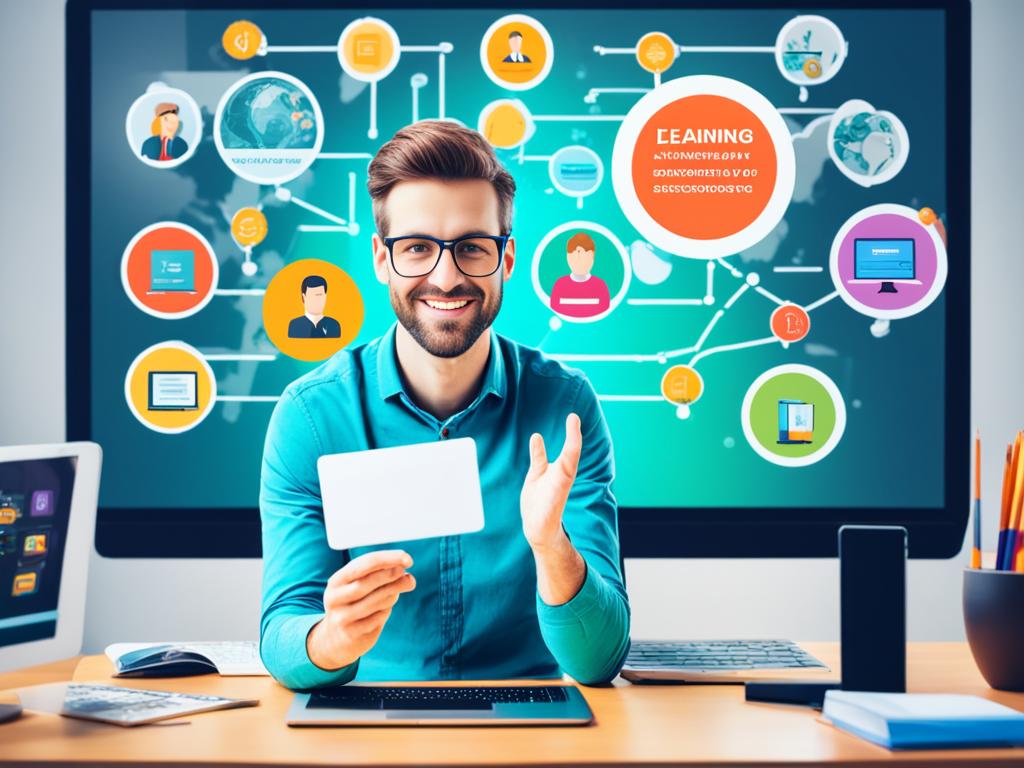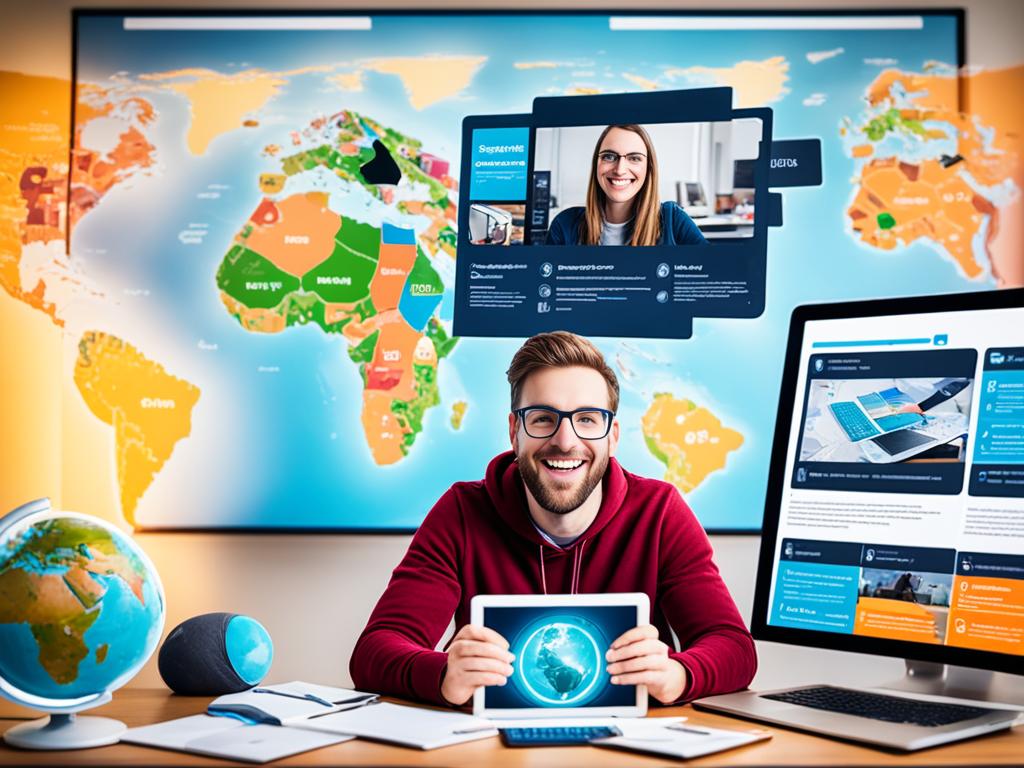
E-Learning: Impact and Benefits in Digital Age Education
Technology has changed how we learn, bringing us into the era of e-learning. This new way of learning uses digital platforms and online tools. It has changed how we get knowledge and skills in today’s digital world.
E-learning includes many types of online learning, like online courses and MOOCs. It uses technology to change education for the better.
E-learning has made learning easier and more accessible. It lets people learn from anywhere, anytime. This has made quality education available to more people, helping them reach their goals.

We’re going to look at how e-learning is changing education. We’ll see how it’s making learning more engaging and affordable. It is changing the way we learn, making education better for everyone.
Embracing E-Learning: The Future of Education
The digital age is changing how we learn. Virtual classrooms are becoming key. With online education, thanks to LMS and MOOCs, students can learn from anywhere. This is changing how we get and use educational content.
The Rise of Virtual Classrooms
Virtual learning platforms let students learn from home. They use tech like video calls and interactive media for engaging lessons. This makes learning flexible and open to more students, especially those who couldn’t get to traditional classes.
Overcoming Geographical Barriers
Online learning lets students reach beyond their local schools. They can join courses from anywhere in the world. This opens up new subjects and perspectives for learners.
LMS and MOOCs play a big part in this. They help teachers share lessons globally. This creates a connected and collaborative learning space.

Personalized Learning Experiences with E-Learning
It has changed how we learn, making education more personal. Unlike old-school classrooms, e-learning adjusts to what each learner needs and likes. This means learning is tailored just for them.
Virtual learning shines with its personalized learning. It uses smart algorithms to watch how learners do, spot their strengths and areas to work on. Then, it changes the content and how it’s delivered. This adaptive learning method makes sure learners get the right help and materials to do well.
Also, it lets learners pick how they want to learn. If they like pictures, sounds, or hands-on activities, there’s something for everyone. This variety helps learners stay interested and understand better.

Thanks to technology, e-learning lets teachers craft learning paths that meet each student’s needs and goals. This approach makes learning more engaging, leads to better results, and makes education more rewarding for everyone.
E-Learning: A Cost-Effective Solution
In today’s digital world, e-learning is changing education. It makes learning cheaper and opens doors for everyone. With technology, e-learning cuts down on costs that once blocked access to good education.
Reducing Educational Costs
E-learning cuts down on education costs big time. It doesn’t need classrooms or big buildings. So, it’s cheaper than traditional schools.
This helps both students and schools. Students save money, and schools can spend more on quality learning stuff. Everyone wins.
Democratizing Access to Quality Education
Virtual learning also makes sure everyone can get good education. It doesn’t matter where you live. So, people in far-off places get the same chances as city folks.
This makes education fairer. It helps people from all walks of life chase their dreams. It’s good for society as a whole.

It is leading the way in making education affordable and open. It uses technology to change how we learn. This means more people around the world can get a great education.
Enhancing Learner Engagement with E-Learning
In today’s digital world, virtual learning has changed how we learn. It makes learning more engaging by using interactive and multimedia tools. These tools help teachers create fun and deep learning experiences. This keeps students interested and motivated in their studies.
Interactive and Multimedia Learning Resources
E-learning offers many interactive and multimedia tools that go beyond the classroom. Tools like simulations, games, videos, and virtual reality make learning exciting. They help learners understand subjects better.
Gamification is a big part of e-learning. It turns learning into a game with points, badges, and leaderboards. This makes learners want to solve problems and compete, which boosts their engagement and memory of what they learned.
Using multimedia like videos, animations, and presentations makes learning more engaging. These tools help explain tough topics and fit different learning styles. This way, every student can do well in e-learning.

It combines interactive and multimedia tools for a fun and effective learning experience. This leads to better engagement, memory, and a positive learning outcome.
The Flexibility of E-Learning Programs
In today’s digital world, e-learning has changed the way we learn. It lets students learn at their own pace, anytime, anywhere. This means they can enjoy flexible learning and self-paced education without being tied to a classroom.
With online learning, students can get to course materials and lessons 24/7. They can log in from anywhere with internet, making it easy to fit learning into their busy lives. This 24/7 access is great for those with work or family commitments, as it means no more strict class times.
It also lets students move through the curriculum at their own speed. They can go back to tough topics, spend more time on what interests them, and make their learning fit their needs. This self-paced education helps them understand and remember better.
E-learning also changes how we get information. With things like interactive videos, simulations, and games, studying becomes more fun and engaging. This makes the learning experience more dynamic and enjoyable for everyone.
By choosing it, students open up a world of learning that fits their needs and interests. This leads to a more fulfilling and successful learning journey.
E-Learning and the Digital Divide
The digital age is changing how we learn, but it’s also creating a big gap. This gap is called the digital divide. It’s the difference between those who can use digital tech and those who can’t. This gap affects how accessible and inclusive online learning is.
Addressing the Digital Divide Challenges
Many efforts are being made to fix this issue. These plans focus on making digital accessibility and inclusive education for everyone. No matter where you live or how much money your family makes.
- Expanding infrastructure: Governments and groups are working to bring more internet and digital tools to places that don’t have them. This helps make online learning available to everyone.
- Providing affordable devices: Programs are giving out cheaper or free devices like laptops and tablets. This makes sure every student can use online learning tools.
- Enhancing digital literacy: It’s also important to teach people how to use digital tools well. This helps students and teachers make the most of online learning.
By tackling the digital divide, we can make sure everyone can join in on e-learning’s benefits. This way, students from all walks of life can succeed in our digital world.
Integrating E-Learning into Educational Systems
More students want flexible and easy-to-reach learning options. Schools are adding e-learning to their traditional ways of teaching. This mix of online and in-person learning is changing how students learn and talk with teachers.
Blended Learning Approaches
It is making traditional teaching better by adding new ways to learn. It brings together online classes and interactive tools. This means students get learning that fits them, keeps them interested, and makes education available to more people.
Teachers now mix e-learning’s tools like online talks, quizzes, and group discussions with their classes. This way, they use technology well and make sure students get the personal help they need. It helps students grow in school and in life.
FAQ
What is e-learning, and how is it transforming the education landscape?
It uses digital tech and the internet to deliver learning content. It’s changing education by making virtual classrooms possible. It also breaks down barriers and offers learning tailored to each student.
How is e-learning enhancing learner engagement?
It makes learning fun with interactive and multimedia tools. Things like games and simulations make learning more engaging. This makes students more interested and motivated.
What are the cost-effective benefits of e-learning?
E-learning saves money for both students and schools. It cuts costs on classrooms and travel. It also makes quality education cheaper and available to more people.
How does e-learning provide flexibility for learners?
E-learning lets students learn at their own pace, anytime, anywhere. This flexibility helps them manage school with other life tasks. It gives them control over their learning.
How is e-learning being integrated into traditional educational systems?
Schools are adding e-learning to their classes with blended learning. This mix of online and in-person learning uses the best of both. It makes learning better overall.
What challenges does the digital divide pose for the widespread adoption of e-learning?
The digital divide, or the gap in tech access and skills, is a big hurdle for e-learning. Fixing this gap is key to making sure everyone can access online learning.



E-learning has impacted positively in the education sector cause it’s makes learning easy and interactive.